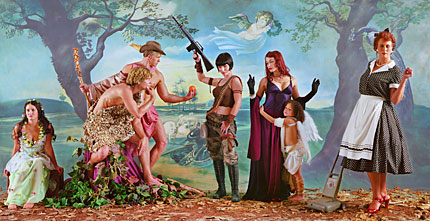
Judgement of Paris, Eleanor Antin, 2007
Fecha de producción: 2007
Tipos de obras
Audiovisual
Obra gráfica
Géneros
Arte > Pintura
Arte > Escultura
Arte > Fotografía
Arte > Dibujo
Arte > Performance
Arte > Instalación
Movimientos socio-culturales
Edad Contemporánea > Feminismo

Judgement of Paris, Eleanor Antin, 2007
The photograph Judgment of Paris (after Rubens) - Dark Helen is part of a work belonging to the series Helen's Odyssey, from 2007. It has another version entitled Judgment of Paris (after Rubens) – Light Helen.
The photograph was part of the great exhibition at the British Museum in London "Troy: Myth and Reality", held from 21-11-2019 to 08-03-2020.
Since 2001, she has completed three series of allegorical photographs based on Roman life: "The Last Days of Pompeii", "Roman Allegories" and "Helen's Odyssey".
In an interview, the author explains the reason for her photography series:
"All my life I have had a passion for ancient Greece, ever since I read Bulfinch's Mythology as a child. When I first read it, I wished I could live in ancient Greece. But then, later, when I found out how badly women were treated, I cheated a bit and switched my allegiance to ancient Rome, where women had some rights and might even have lived interesting lives...".
"Helen is always vilified as a seductress and admired for her beauty and feared for her power; however, no matter the way she is interpreted, her place in our historical fantasy has always been legitimised, written or painted by men. I wanted to humanize this woman, to find her under the cover of stories that obscure her to us."
Sholis, Brian (2008). "Eleanor Antin discusses her recent photographic series", Artforum, (retrieved on14/05/2021). <https://www.artforum.com/interviews/eleanor-antin-discusses-her-recent-photographic-series-20824>
In the 1970s, a new feminist wave began to flourish, affecting the theoretical and university sphere as well as the art movement.
Miriam Schapiro creates the femmage category, a collage style that uses materials, objects and craft techniques culturally identified with women.
Judy Chicago creates The Dinner Party, a ceremonial table. On each side of the triangular table there are 13 services with ceramics, embroidered tablecloths and the names of the 39 guests, including Sappho, Aspasia, Theodora and Hypatia. On the white tiles on which the table sits are inscribed the names of 999 other women including Erinna, Cleobulina, Theano, Julia Domna, Clodia, an many other Greek and Roman women.
Eleanor Antin also dynamites, with fine irony, the idealised constructions of feminity in the imagery that the classical world has transferred to our days.
-CUC: Block Continuity of cultural heritage. Mythology and religion.
-Latin 4th ESO: Block Legacy and heritage.
(In the previous subjects, photographic works related to classical mythology may be used.)
-History of Art 2nd Baccalaureate: the whole of his work can be dealt with.
Búsqueda en todos los campos de texto: Lo que escribas en este campo se buscará en todos los campos de texto, en todas las categorías. Puedes escribir una única palabra, o buscar una frase completa si la escribes entre comillas. También te permite encadenar distintas palabras utilizando AND o OR, por ejemplo puedes buscar "familia aristocrática" AND "poeta" y los resultados deberán contener las dos palabras o "familia aristocrática" OR "poeta" y entonces conque contengan una de ellas, ya saldrán en la lista de resultados.
Búsqueda por jerarquías: Encontrarás diferentes jerarquías que podrás desplegar pulsando sobre ellas, podrás seleccionar el nivel o niveles de la jerarquía que quieras, los elementos seleccionados se buscarán utilizando un criterio OR, es decir, con que cumplan uno de ellos ya saldrá en la lista de resultados.
Búsqueda por textos: Encontrarás diferentes campos de texto que aplican a las distintas categorías, las reglas de uso son las mismas que se utilizan en el punto 1, pero en este caso estás búscando en un campo en concreto, no en todos a la vez, es decir, por ejemplo, puedes buscar "familia aristócrata rusa", solamente en el campo Biografía de un personaje.
Unión de los filtros de selección: También en la parte superior encontrarás un selector en el que establecerás el criterio de ordenación de la salida.